Burner Management System Market Research, 2032
The global burner management system market size was valued at $5.6 billion in 2022, and is projected to reach $9.9 billion by 2032, growing at a CAGR of 6.2% from 2023 to 2032. An integrated control system called a burner management system (BMS) is created to monitor, manage, and secure the operation of combustion equipment. Furnaces, ovens, boilers, and heaters are just a few examples of industrial processes that utilize BMS. A burner management system’s main role is to make sure the burner operates safely and effectively while reducing the chance of accidents, improving combustion performance, and adhering to safety rules.
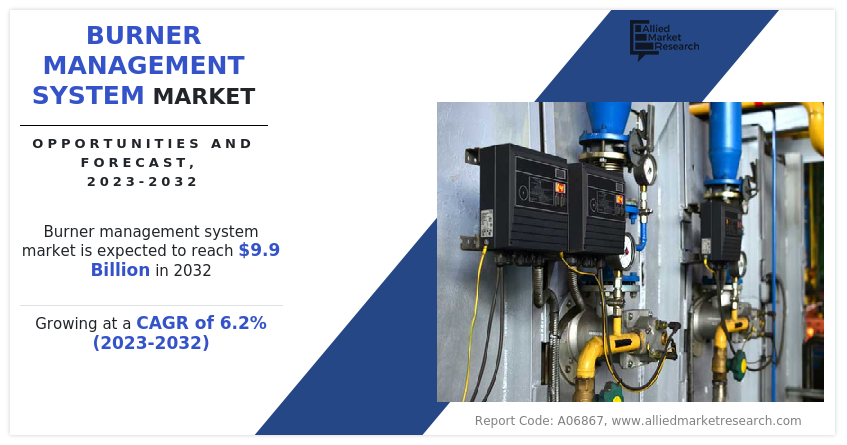
The installation of burner management system in both new and existing heaters is essential due to increased government legislation and regulations, as well as an increase in accident lawsuits. The development of this market has also been significantly impacted by rapid industrial growth. Every industry that uses heaters or burners has safety as a top priority. Any heating issues in these businesses could result in significant losses of life, property, and money. In addition, Governments across the globe have implemented stringent regulations to enhance safety standards in industries. These regulations mandate the installation of advanced safety systems, including BMS, to prevent accidents, minimize environmental impact, and protect workers. Compliance with these regulations drives the adoption of BMS in various industrial sectors.
Retrofitting burner management systems into existing industrial facilities can be challenging. Compatibility issues with legacy systems, complexities associated with integrating with other control systems, and the need for extensive system testing can delay or hinder the adoption of burner management systems. This is one of the major factors projected to hamper the burner management system market revenue growth during the forecast period.
Particularly in industries like oil & gas, electricity generation, and manufacturing, developing countries are rapidly industrializing. Manufacturers of burner management systems have a chance to offer their products in these markets as new facilities are built or as old ones undergo expansion and modernization. There are prospects for improved system integration and operational efficiency when burner management systems are integrated with cutting-edge control systems like distributed control systems (DCS) and programmable logic controllers (PLC). Through better coordination and management of burner operations, this integration enhances performance in general and reduces costs.
The key players profiled in this report include ABB, Cimarron Energy. INC. Emerson Electric Co., Honeywell International Ino., Schneider Electric SE., Tundra Process Solutions, Pilz GmbH & Co. KG, ACL Manufacturing Inc., Combustex Corp., and Rockwell Automation. Inc. Investment and agreement are common strategies followed by major market players. For instance, in November 2019, Cimarron Energy, INC. introduced the most cutting-edge burner management system. The ARControl Dual burner management system is intended to help oil & gas producers. It uses a single control box to operate equipment with two burners.
The burner management systems market is segmented on the basis of platform, fuel, end use, component, application, and region. By platform, the market is divided into programmable logic controller and distributed control system. By fuel, the market is classified into gas, oil, and others. By end use, the market is classified into oil & gas, power, pharmaceutical, chemical, and others. By component, the market is classified into software and hardware. By application, the market is classified into multiple burner and single burner. By region, the market is analyzed across North America, Europe, Asia-Pacific, and LAMEA.
The burner management system market outlook is segmented into Platform, Fuel, End-use, Component and Application.
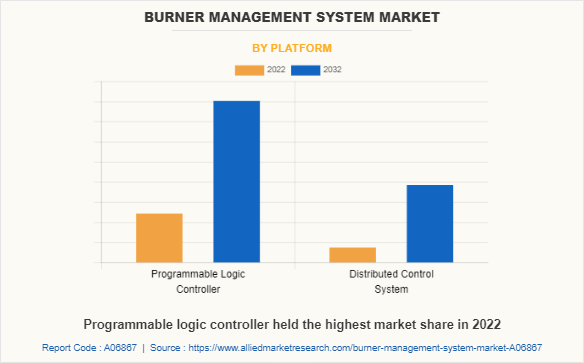
By platform, the programmable logic controller sub-segment dominated the market in 2022. Programmable logic controllers (PLCs) provide a high level of flexibility and customization options, allowing BMS manufacturers to design and implement tailored solutions for different types of burners and industrial applications. This flexibility is crucial as burners vary in size, complexity, and fuel type, requiring adaptable control systems. Moreover, PLCs offer advanced automation capabilities, allowing for precise control and optimization of burner operations. In addition, safety is a critical concern in burner management systems, and PLCs play a key role in ensuring safe burner operation. They incorporate safety features, such as emergency shutdowns, flame monitoring, and fault detection, to prevent accidents, protect equipment, and safeguard personnel. PLCs are known for their reliability and can operate in harsh industrial environments with high levels of vibration, temperature, and humidity. Furthermore, burner management systems require high reliability to ensure continuous and safe operation. Programmable logic controller is known for its robustness, durability, and built-in redundancy features. It is designed to operate reliably in harsh industrial environments and has built-in diagnostics and fault-tolerant capabilities. The reliability and redundancy offered by programmable logic controllers make them a preferred choice for critical burner management applications. These are predicted to be the major factors affecting the burner management systems market size during the forecast period.
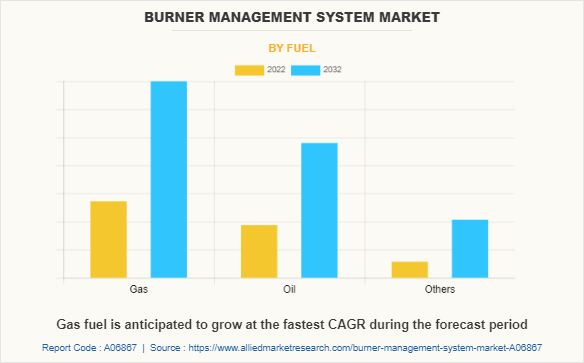
By fuel, the gas sub-segment dominated the global burner management system market share in 2022. Gas is considered a cleaner fuel compared to coal and oil, as it emits fewer pollutants and greenhouse gases. The increasing awareness and regulations aimed at reducing emissions have led to an increase in demand for gas as an energy source. Therefore, the demand for burner management systems specifically designed for gas-fired applications has increased. Moreover, gas-fired burners are extensively used in various industrial and commercial applications, including power generation, oil & gas processing, chemical plants, refineries, and food processing. These sectors require efficient and reliable burner management systems to ensure safe and optimal operation of the burners. Furthermore, gas burner management systems offer enhanced operational efficiency and cost savings compared to traditional burner systems. They incorporate advanced features such as intelligent control algorithms, remote monitoring capabilities, and diagnostic tools that optimize fuel consumption, reduce downtime, and improve overall system efficiency. Industries are increasingly adopting gas burner management systems to achieve these operational benefits.
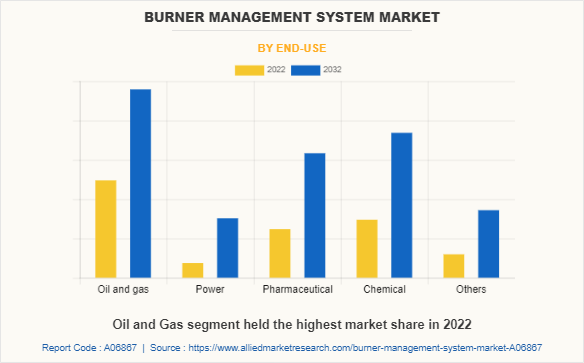
By end use, the oil & gas sub-segment dominated the global burner management systems market share in 2022. The oil & gas industry relies heavily on burner systems for various applications such as refining, petrochemical processing, and power generation. Burner management systems enable efficient control and optimization of combustion processes, resulting in improved energy efficiency, reduced emissions, and lower operating costs. The desire to enhance process efficiency and productivity drives the demand for advanced BMS solutions in the oil & gas sector. Burner management systems are essential for ensuring the safe and reliable operation of burners, boilers, and other combustion equipment. Furthermore, the liquefied natural gas (LNG) industry has witnessed substantial growth in recent years, driven by increasing demand for clean-burning fuel and the rise in natural gas production. LNG terminals and facilities utilize burner systems for the regasification process, power generation, and other applications. The expansion of the LNG industry creates opportunities for BMS providers to offer specialized solutions tailored to the unique requirements of LNG operations.
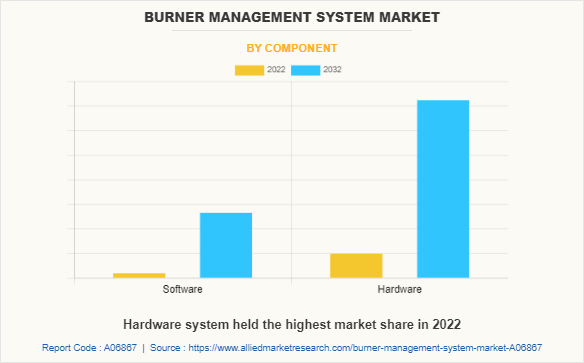
By component, the hardware sub-segment dominated the global burner management systems market share in 2022. Burner management systems are crucial for ensuring safe and reliable operation of industrial burners in various applications, including oil refineries, chemical plants, power generation facilities, and others. Stringent safety regulations and standards set by government bodies and industry associations mandate the installation of BMS to prevent accidents, minimize the risk of fires and explosions, and protect personnel and assets. The hardware components of BMS, such as flame detectors, temperature sensors, and control panels, play a critical role in achieving compliance with these safety requirements. Moreover, energy efficiency has become a significant focus for industries globally due to the need for cost savings and environmental sustainability. BMS hardware components, such as variable frequency drives (VFDs), pressure regulators, and combustion control systems, enable precise control of burner operations, optimizing fuel consumption and reducing wastage. The increasing emphasis on energy efficiency is driving the adoption of advanced hardware solutions in the BMS market. Retrofitting existing burner systems with advanced BMS hardware components is another driver of the burner management system industry. Many industrial facilities are modernizing their aging burner systems to improve safety, efficiency, and compliance with the latest standards. Retrofitting projects involve the installation of new sensors, control panels, and other hardware components, driving the demand for BMS hardware in the market.
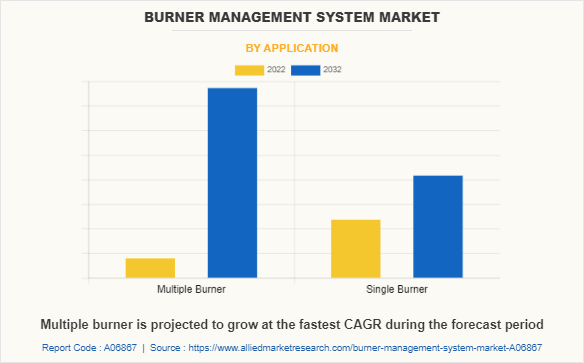
By application, the single burner sub-segment dominated the global burner management systems market share in 2022. Single BMS offers a cost-effective solution for small-scale industrial applications that require burner control and safety measures. These systems are relatively simpler and less expensive compared to multi-burner systems, making them a popular choice for budget-conscious customers. Furthermore, single BMS provides flexibility in terms of installation and configuration. It can be easily integrated into existing burner systems without major modifications or disruptions. In addition, if the industrial process requires expansion or additional burners in the future, single BMS can be easily scaled up or replicated, making it a flexible choice for future needs. Furthermore, burner management systems play a critical role in ensuring the safe operation of burners and related equipment. Single BMS provides essential safety features such as flame detection, fuel and air flow control, and emergency shutdown capabilities. These systems help industries comply with stringent safety regulations and prevent accidents, thereby safeguarding personnel, assets, and the environment. Moreover, single BMS optimizes burner performance and improves operational efficiency. It ensures accurate and precise control of fuel and air ratios, enabling efficient combustion, reduced emissions, and improved energy utilization. By maintaining optimal burner operation, single BMS helps industries enhance productivity and reduce operational costs.

By region, North America dominated the global market in 2022 and is projected to be the fastest-growing region during the forecast period. BMS plays a critical role in ensuring the safe and efficient operation of burners, adhering to regulations in the region. The need for compliance with these regulations drives the demand for advanced BMS solutions in the region. There is a rising emphasis on industrial safety across various sectors in North America. Burner incidents can lead to catastrophic accidents, such as fires and explosions. To mitigate these risks, companies are adopting advanced BMS solutions to enhance safety measures, monitor burner operations, and prevent accidents. Burner management systems help optimize burner performance, enhance operational efficiency, and reduce fuel consumption. Therefore, the rising demand for energy acts as a driver for the BMS market in the region. The replacement of aging infrastructure is also predicted to create opportunities for BMS providers in the region. The growth of the oil & gas industry, along with the need for efficient burner control, boosts the demand for BMS solutions in North America.
Impact of COVID-19 on the Global Burner Management System Industry
- COVID-19 impact has caused a global economic downturn, leading to reduced investments and capital expenditures by various industries. Many companies have faced financial challenges, resulting in delayed or canceled projects. This has affected the demand for burner management systems as companies prioritized essential expenditures and put non-essential projects on hold.
- The COVID-19 pandemic disrupted global supply chains, affecting the production and delivery of burner management system components and equipment. Manufacturing facilities and logistics networks have faced closures, restrictions, and reduced capacities, leading to delays in production, shortages, and increased costs. This has impacted the availability and timely delivery of burner management systems.
- The pandemic has created uncertainty and volatility in the business environment. Companies have become more cautious about their spending, prioritizing essential operations and cost-cutting measures. This cautious approach has impacted the decision-making process for adopting new burner management systems.
Key Benefits For Stakeholders
- This report provides a quantitative analysis of the burner management system market forecast, segments, current trends, estimations, and dynamics of the burner management system market analysis from 2022 to 2032 to identify the prevailing burner management system market opportunities.
- The research study also offers information related to burner management system market opportunity, key drivers, and restraints.
- Porter's five forces analysis highlights the potency of buyers and suppliers to enable stakeholders make profit-oriented business decisions and strengthen their supplier-buyer network.
- In-depth analysis of the burner management system market segmentation assists to determine the prevailing market opportunities.
- Major countries in each region are mapped according to their revenue contribution to the global market.
- Market player positioning facilitates benchmarking and provides a clear understanding of the present position of the market players.
- The report includes the analysis of the regional as well as global burner management system market trends, key players, market segments, application areas, and burner management system market growth strategies.
Burner Management System Market Report Highlights
| Aspects | Details |
| Market Size By 2032 | USD 9.9 billion |
| Growth Rate | CAGR of 6.2% |
| Forecast period | 2022 - 2032 |
| Report Pages | 367 |
| By Platform |
|
| By Fuel |
|
| By End-use |
|
| By Component |
|
| By Application |
|
| By Region |
|
| Key Market Players | Combustex Corp., Rockwell Automation, Inc., Pilz GmbH & Co. KG, ABB, Emerson Electric Co., Cimarron Energy, INC., ACL Manufacturing Inc., Honeywell International Inc., Schneider Electric SE., tundra process solutions |
Stringent safety regulations imposed by governments and regulatory bodies worldwide to drive the demand for burner management systems. These regulations aim to prevent accidents, protect personnel, and minimize environmental risks. Compliance with safety standards and regulations requires the installation of reliable and efficient burner management systems which is expected to create opportunities for the market.
Many industrial facilities have aging burner management systems that require replacement or upgrade. The need to modernize existing systems with advanced technologies and comply with the latest safety standards drives the demand for new burner management systems. Retrofitting older systems with newer BMS solutions helps improve safety, reliability, and overall operational efficiency.
The on-premises sub-segment of the platform acquired the maximum share of the global burner management system market in 2022.
The burner management system market benefits from ongoing technological advancements. Innovations such as the integration of Internet of Things (IoT), cloud-based monitoring systems, advanced flame detection technologies, and predictive analytics enhance the capabilities and performance of burner management systems. These technological advancements attract industries seeking more efficient and advanced solutions for their combustion processes.
Asia-Pacific is projected to provide more business opportunities for the global burner management system market in the future.
ABB, Cimarron Energy. INC. Emerson Electric Co., Honeywell International Ino., Schneider Electric SE., Tundra Process Solutions, Pilz GmbH & Co. KG, ACL Manufacturing Inc., Combustex Corp., and Rockwell Automation. Inc. Limited are the major players in the burner management system market.
The major growth strategies adopted by burner management system market players are investment and agreement.
The oil & gas and chemical industries are the major customers in the global burner management system market.
The report provides an extensive qualitative and quantitative analysis of the current trends and future estimations of the global burner management system market from 2022 to 2032 to determine the prevailing opportunities.
Loading Table Of Content...
Loading Research Methodology...



